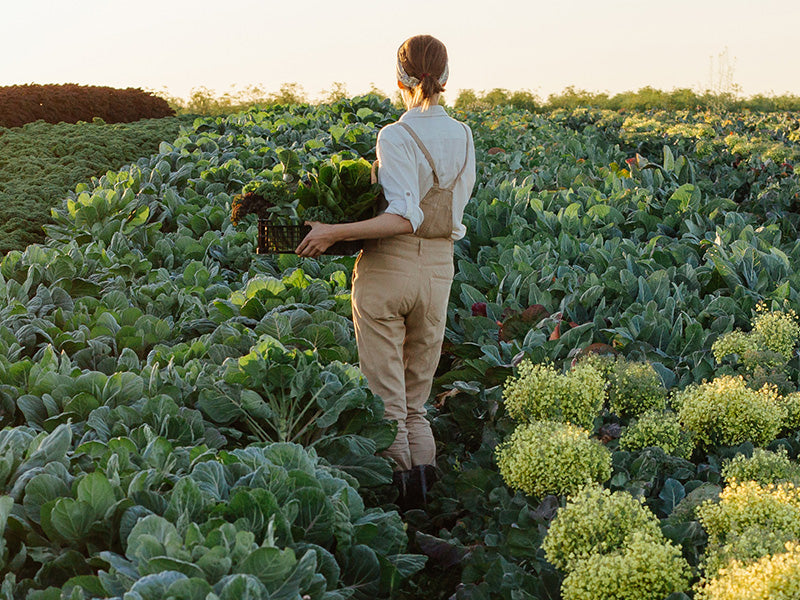New Chapter is part of a growing agricultural movement that goes beyond organic, called Regenerative Agriculture. Regenerative techniques have the power to reverse the worldwide depletion of farmable topsoil and to lower atmospheric carbon dioxide (CO2) levels. New Chapter passionately supports Regenerative Agriculture because we believe it’s essential for the healthy future of people and planet. We're also excited to step into the world of Regenerative Organic Certified® products, following some of the highest organic standards in the world.
What is Regenerative Agriculture?
Right now, the agricultural sector has become one of the largest emitters of carbon dioxide (CO2) into our atmosphere. Agriculture and land use are responsible for around 18% of human-created emissions of CO2. When combined with methane (CH4), these two harmful greenhouse gases (GHGs) are major contributors to the largest threat ever imposed on the human race: climate change. We are talking, of course, about climate change. Industrial agriculture is also linked to global soil degradation and global food insecurity. Monocropping, tilling, and petrochemical use contribute to loss of topsoil and the "desertification" of arable land. According to the United Nations Convention to Combat Desertification, soils are eroding 100 times faster than they can be naturally replenished.
Fortunately, an effective and science-based solution lies right beneath our feet—in the soil itself. Regenerative Agriculture is a type of farming system with a centralized focus on improving soil health and biodiversity, watershed capacity, and restoring the ecosystem services provided by the overall farming system. To put it simply, Regenerative Agriculture is a method of farming that aims to improve resources and quality of life, rather than destroying or depleting them. That’s what sustainability is all about, isn’t it?!
At scale, Regenerative Agriculture offers humans the single most effective tool to mitigate the impacts of climate change. Through regenerative practices like cover cropping, composting, crop rotation, and rotational grazing, farmers can actively counter the current global accumulation of atmospheric carbon by sequestering it in the soil and in above-ground biomass.
What Makes Regenerative Agriculture So Different?Let’s look at different farming practices to understand how regenerative methods take a uniquely holistic approach. 
Conventional AgricultureConventional agriculture (also referred to as Industrial or "extractive" agriculture), refers to the large-scale, intensive production of crops and livestock. These methods were introduced in the United States and other parts of the world primarily following WWII. Today, this “modern” approach to farming relies on the extensive use of genetically modified organisms (GMOs), petro-based chemical fertilizers, herbicides, fungicides, and other synthetic continual inputs in order to maximize efficiency and therefore the overall production of the farm. Although conventional methods do produce an abundance of food at affordable prices, the true cost of production is often not taken into account. These costs are major impacts on the environment, global climate, and human health. Industrial agriculture also relies on the use of extensive irrigation and mechanical tillage, which over time destroys soil structure, decreases soil biota, and leaves the topsoil susceptible to increased erosion. Erosion is a significant problem in the US due to the use of monoculture—growing only one crop. Monoculture makes the soil prone to rapid erosion since the soil is left bare outside of the crop’s growing season, among other drawbacks. Organic FarmingOrganic farmers may use some industrial methods such as monoculture and tilling, but they also follow a set of specific certification standards that include growing foods without synthetic pesticides, herbicides, fertilizers, or GMOs. Experts like Rodale Institute cite organic methods as a good way to avoid ingesting harmful chemicals such as glyphosate, since synthetic herbicides and 100s of other chemical additives are banned under the National Organic Program. Regenerative OrganicRegenerative organic agriculture builds on these important organic standards by applying farming methods that respond to site-specific conditions. Growers who follow regenerative principles view their land, workers, animals, and waste materials as an interconnected web. The entire agricultural operation is viewed as a single living entity and integrates cultural, biological, and mechanical practices that foster cycling of resources, promote ecological equilibrium, and conserve biodiversity. The result is a regenerative farming strategy that helps heal the soil, repair global insecurity, and reverse climate change. Recently, advocates have taken Regenerative Organic the next step by creating a standardized Regenerative Organic Certification. |
Benefits of Regenerative Agriculture
The benefits of regenerative agriculture are the benefits of having rich, healthy soil for growing our food. It’s nothing less than improving the overall health of people and their communities.
Restored Soil
The health of our soil is vital for maintaining the health of our plants (our food). Soil health is closely linked to overall human health. When done properly and at scale, the effects of improving soil health reach far beyond healthier plants and people. Focusing on soil heath allows farmers to naturally maximize yields and overall crop health naturally, without the use of synthetic inputs. Regenerative organic agriculture not only maximizes crop health and yield but maintains those yields over time. With more research being conducted at the field level, we are now learning that organically (and therefore by extension regeneratively) maintained land has significantly higher crop yield per acre. According to the Rodale Institute, organic yields can be 30% higher than conventional. We are also learning that food grown on regenerative organic land is now showing a 40-50% improvement in gross margins on certain crop varieties and single digit improvements on commodity crops for farmers, if they switch to regenerative practices.
A Safer Climate
Reversing climate change sounds amazing, doesn’t it? Here’s how the right farming techniques are starting to make it reality. Plants naturally draw down CO2 from the atmosphere through photosynthesis and store that carbon in the soil. But industrial farming practices, like tilling and monoculture, disrupt this system, releasing the CO2 back into the atmosphere as well as depleting the soil. When industrial practices are replaced with regenerative ones, it can reboot the natural cycle of removing carbon from the air by keeping it (sequestering it) in the ground. Modest calculations show carbon can be sequestered this way by the TON. According to the Rodale Institute, we could sequester more than 100% of current annual CO2 emissions with a switch to regenerative organic agriculture. Soil regeneration practices create healthy, carbon-rich soil that is full of organic matter and holds water like a sponge.
More Nutritious Food
Regeneratively farmed ingredients are healthier for Mother Earth. They’re also literally more nutritious than conventionally farmed ingredients. Current industrial farming systems have been depleting soil nutrient content and quality for decades. This means that food grown in that soil has fewer nutrients—vitamins, minerals, and plant compounds. Regenerative techniques can reverse this trend, restoring soil quality and nutrient value to produce food that is more nutrient dense.
Regenerative Agriculture Farming MethodsRegenerative agriculture is about reconnecting and managing the farming system with a combination of holistic, forward-thinking principles. 
OrganicRegenerative methods follow set organic standards to avoid synthetic pesticides, herbicides, fertilizers, and GMOs. Cover CropsAlso called “green manure” and “living mulch,” cover crops are planted between growing seasons to help protect soil from erosion and nutrient loss. CompostComposting is repurposing organic matter from the waste cycle to enrich soil. Home composting, for example, involves adding decomposed kitchen scraps and yard waste to your garden. Composting can be done at the farm level and it helps retain soil moisture and keep carbon on (and in!) the land. Crop RotationCrop rotation is an age-old practice of planting different types of plants one after the other in the same field. Different plants require different nutrients and are affected by different pests and issues. So mixing crops over time can help soil stay balanced and healthy. Planting a rotation of legumes, such as beans, can even add back nutrients, specifically nitrogen, to enrich the soil for future planting. IntercroppingIntercropping is another traditional technique of planting more than one crop together at the same time. It has similar advantages to crop rotation with the added benefit of yielding multiple types of harvests at the same time. Intercropped plants have different root structures that can help hold topsoil and build biodiversity. Low/No TillingTilling soil is turning over the top layers with a plow to prepare it for planting, but it has the effect of breaking up soil matter and releasing carbon. Avoiding tillage completely or using low-till methods helps soil retain its intricate structure, microbial balance, and sponge-like ability to retain water. AgroforestryAgroforestry integrates trees and shrubs into farming systems to form more diversified landscapes. This practice can help reconnect whole, functional ecosystems with nourished, stable soil while also providing a variety of food. Restorative GrazingDid you know over 2/3 of global agricultural land area is grazing land? If this land can be managed regeneratively, it would result in significant carbon sequestration on our planet. Regenerative grazing techniques generally involve moving livestock herds in highly managed ways that would be similar to how land is grazed in nature—including giving land time to recover after foraging. Perennial CropsPlanting perennial crops that do not need to be disturbed or replanted every year helps ensure the soil has a complex system of living roots all year round. |
Is There a Regenerative Agriculture Certification?
Yes! In recent years, there have been advances within the standards and certification programs that govern agricultural practices and can independently verify that various crops, livestock, or raw materials are grown in a more sustainable way. In 2018, the Rodale Institute helped to introduce a new, holistic, high-bar standard for agriculture certification: Regenerative Organic Certified®, or ROC. ROC is overseen by the Regenerative Organic Alliance (ROA), a non-profit made up of experts in farming, ranching, soil health, animal welfare, and farmer and worker fairness.
The USDA Certified Organic seal continues to be a rigorous standard, but shortfalls do exist when it comes to soil health and animal welfare requirements. Most importantly, organic certification omits the treatment of farmers and farm workers. Many brands, farmers, ranchers, and nonprofits felt that additional holistic standards could be even more effective.
The 3 Regenerative Organic Certified Pillars
The ROC program uses three pillars with the goal of matching and then surpassing other types of certifications.
Soil Health: Covers use of regenerative practices like cover crops, crop rotation, and conservation tillage. Builds organic matter and promotes biodiversity with no synthetic inputs or soil-less systems.
Animal Welfare: Protects the “Five Freedoms” (including freedom from discomfort, pain, and fear), governs the use of grass-fed & pasture-raised, and restricts the use of concentrated animal feeding operations (CAFOs).
Social Fairness: Ensures fair payments and living wages for farmers and farmworkers, safe working conditions, capacity building, and democratic organizations.
New Chapter Regenerative Products Are Here!
We’re passionate about the good that Regenerative Agriculture can do for ecosystems and communities, and we’re on a mission to add more regenerative ingredients to our portfolio. We currently formulate our Turmeric Force™ herbal supplement with regeneratively grown supercritical Turmeric.
We’re also super-excited to announce our FIRST Regenerative Organic Certified® product, Organic Holy Basil Booster Powder. This is an easy-to-use herbal addition that helps relieve occasional stress and supports cognitive and immune function.*
The Future of Farming
The time for regenerative agriculture is now! The earth is on the brink of irreversible damage to its soil and its atmosphere. In our lifetimes, right now, we’re seeing the negative effects of climate change and soil depletion.
You can take action by talking to your grocer, workplace, farmer’s market, and local schools about carrying and serving products that are regeneratively farmed. You can read labels and look for regeneratively farmed ingredients. Try regenerative techniques in your own garden, too!
Regenerative Agriculture provides change mechanisms that improve the quality of life, create greater resiliency, and increase family and community capital of those who reside within a regenerative landscape. Sounds like a win-win for all!
Written by New Chapter staff






